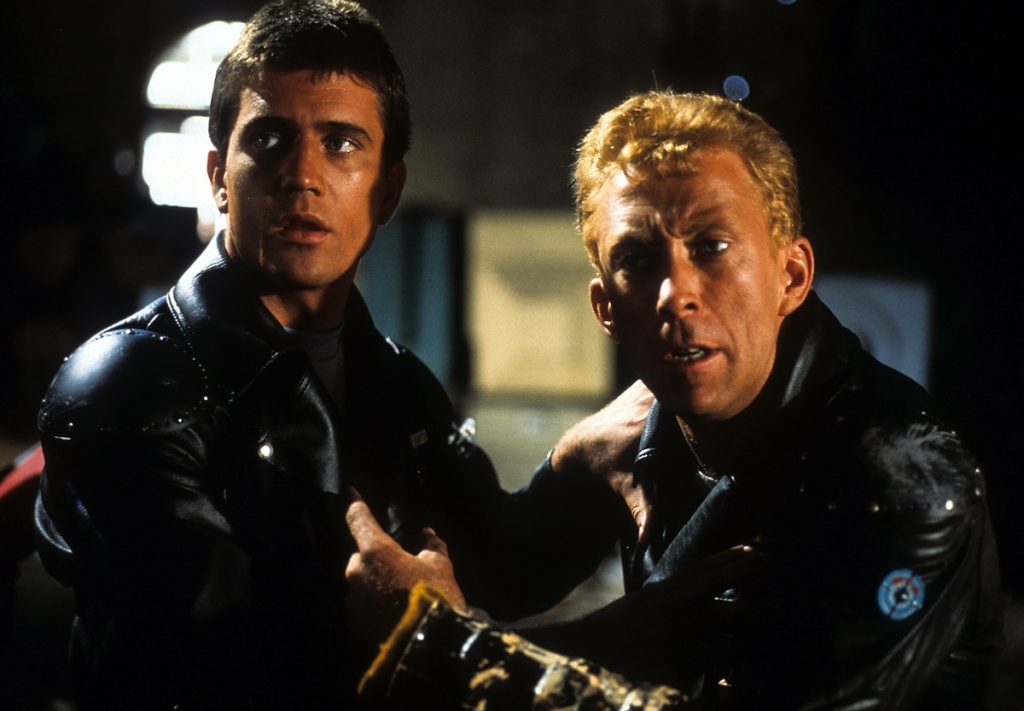It’s been forty years since the brainchild of director George Miller burst onto cinema screens, with a baby-faced and leather-clad Mel Gibson hunting bikers in a lawless Australia. Mad Max is a landmark in Australian film history, helping expand the Australian New Wave movement to international markets and in turn becoming one of the most profitable films in history. When discussing his 1979 debut, George Miller is often cited as having wanted to create a B-grade exploitation film with the aspirations of an A-grade Hollywood film, and that couldn’t be truer when revisiting the film today.
Mad Max has the kinetic energy and spectacle that you would expect of a blockbuster film from an era that was entranced in the excitement of Jaws and Star Wars. As a result, an Australian film icon was born, one that would eventually be accepted universally by the time of its sequels. Even with a shoe-string budget (involving editing the film in an old apartment), George Miller proved to the world that Australian filmmakers could stand tall in the blockbuster landscape that has since engulfed the cinema world.
Now I’ll be the first to tell you that despite my appreciation for the original Mad Max film, George Miller and Max Rockatansky have well and truly surpassed the aspirations of that film. Mad Max 2 (better known as The Road Warrior in the United States) helped redefine post-apocalyptic fiction, with imagery that has since been replicated and revised over countless film, television and video game properties.
The same can be said about the seminal Mad Max: Fury Road, a film which offered a revisionist take on the Mad Max property, that honed in the absurdity, goofiness and insanity that were unique to George Miller’s world, and cranked that dial up to eleven. The practical effects focused Mad Max: Fury Road managed to thrive in a world where the CGI-heavy blockbuster is king.
As for George Miller well, when you have two films under your belt that many consider to be among the best action films of all time, then rest assured you’ve earned your title as an Australian film icon.
That being said, a lot of the story beats and elements that you see in the original Mad Max have since been transformed or refined in the Mad Max sequels. The Ford Falcons, the goofy haircuts, the simple yet effective dialogue, the high-speed car chases and stunts, the hyper-kinetic camera zooms – it’s all here. All these elements exist in their foundational form, and it’s fascinating to go back and see how the property has evolved.

What makes Mad Max unique is that it unapologetically knows what it is. Within the opening moments of the film, Miller manages to strike a tonal balance in being serious and goofy without compromise. That choice of never being too outlandish, helps ground the film somewhat despite essentially being a comic-book. The Hitchcock inspired soundtrack by Brian May doesn’t hurt either.
Max is a very different character here compared to his later adventures. He isn’t the scrounging, selfish, Clint Eastwood-inspired silent type that he is typically remembered as. Instead we get to see him as a family man, and a mate you could get a beer with, still embodying the qualities of your true-blue Aussie with Mel Gibson, despite his inexperience at the time, managing to bring all those qualities to life in Max. So, when we get to experience Max’s gradual downfall into insanity, watching his world get torn away from him, the result is genuinely impactful, making his acts of revenge satisfying. Call it the John Wick-effect if you will.
The execution of Max’s character arc doesn’t always land however, where scenes involving his wife Jessie (Joanne Samuel) can feel like padding, as Miller works up to the next car stunt. Jessie being underwritten certainly attributes to this. As a result, Mad Max can occasionally feel a little slow, despite coming in at a brisk 93 minutes. Outside of those instances of padding, the script is relatively focused. Giving us the necessary story beats where Max is with his family or Goose (Steve Bisley) to eventually justify his revenge and status as a tragic anti-hero. Again, these are all elements that are refined in the later Mad Max films, where action and spectacle are used to keep those films lean and focused.
Toecutter and his gang in particular, certainly act as a precursor to what we’d see in Mad Max: Fury Road with Hugh Keays-Byrne’s other Mad Max cult leader Immortan Joe. What’s fascinating about Toecutter’s gang is Miller’s choice to deromanticize the bikie counter culture. Whereas Easy Rider enticed a glorified freedom, to which subsequent bikie films such as Australia’s own Stone, revelled in that freedom; Mad Max chooses to make Toecutter’s gang a group of insane hooligans, which only helps make the film feel more unique.
Mad Max will forever be an icon of Australian cinema, not only proving to the world that a successful blockbuster can be put together on a shoestring budget, but that Australia had blockbuster directors of the calibre of George Miller that could appeal to a worldwide audience. Yes, the original has since be surpassed by vastly superior sequels, however there is certainly a degree of respect and appreciation for the film that established the mould for future Mad Max films and ingrained Australian films at the worldwide box office.
I am the Knight Rider!
Director: George Miller
Cast: Mel Gibson, Hugh Keays-Byrne, Steve Bisley
Writers: James McCausland, George Miller, (based on a story by George Miller and Byron Kennedy)



